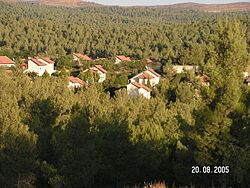Livne: Difference between revisions
reinsert info which was removed by IP in May |
|||
| Line 23: | Line 23: | ||
In 2006, Shani-Livne had a population of 416.<ref>Oren Yiftachel -''Ethnocracy: land and identity politics in Israel/Palestine'' 2006 Page 200</ref><ref>''Near East/South Asia report'' 84086 - Page 24 United States. Foreign Broadcast Information Service, United States. Joint Publications Research Service "The new settlements which the Ministerial Committee approved are Livne and 'Ali. Livne will be set up south of Mount Hebron, to the north of Yattir Forest, and during the first phase 30 dwelling units will be constructed in it."</ref> |
In 2006, Shani-Livne had a population of 416.<ref>Oren Yiftachel -''Ethnocracy: land and identity politics in Israel/Palestine'' 2006 Page 200</ref><ref>''Near East/South Asia report'' 84086 - Page 24 United States. Foreign Broadcast Information Service, United States. Joint Publications Research Service "The new settlements which the Ministerial Committee approved are Livne and 'Ali. Livne will be set up south of Mount Hebron, to the north of Yattir Forest, and during the first phase 30 dwelling units will be constructed in it."</ref> |
||
Residents working in Beer Sheva, Arad, at theDead Sea factories, |
|||
communities of Hebron Regional Council, and |
|||
In the central region. Inside the high percentage of university graduates, |
|||
Also in local agriculture as well, the Yatir region is known among Israelis for it's grapes and wine.<ref>[http://www.hrhevron.co.il/_uploads/dbsattachedfiles/hovert.pdf Har Hebron Jewish villages information]</ref> |
|||
==References== |
==References== |
||
Revision as of 22:27, 29 August 2015
Livne
| |
|---|---|
| Hebrew transcription(s) | |
| • standard | Livneh |
| • unofficial | Livna |
 | |
| Country | Israel |
| Council | Har Hebron |
| Region | Hebron Hills |
| Affiliation | Amana |
| Founded | 1982 |
| Website | http://www.shani-livna.org |

Shani-Livne (Template:Lang-he-n, lit. Birch), (Template:Lang-he-n, lit. Scarlet) is a communal Israeli settlement in the southern Judaean Mountains of the West Bank, though some of the village is inside the Green Line and therefore in Israel proper. The international community considers Israeli settlements in the West Bank illegal under international law, but the Israeli government disputes this.[1]
History
Shani-Livne was established in 1982.[2] It is located on the outskirts of Yatir Forest.[3] Located to the south of Hebron, it falls under the jurisdiction of Har Hebron Regional Council. The residents moved into permanent housing in 1989. The community was renamed Shani in memory of Shani Shacham, the son of former members killed in the line of duty.[4]
In 2006, Shani-Livne had a population of 416.[5][6]
Residents working in Beer Sheva, Arad, at theDead Sea factories, communities of Hebron Regional Council, and In the central region. Inside the high percentage of university graduates, Also in local agriculture as well, the Yatir region is known among Israelis for it's grapes and wine.[7]
References
- ^ "The Geneva Convention". BBC News. 10 December 2009. Retrieved 27 November 2010.
- ^ Report on the Palestinians under Israeli rule N. 137, Page 23, 1984
- ^ The Yatir Forest
- ^ To live in the middle of forest, does it get any better…?
- ^ Oren Yiftachel -Ethnocracy: land and identity politics in Israel/Palestine 2006 Page 200
- ^ Near East/South Asia report 84086 - Page 24 United States. Foreign Broadcast Information Service, United States. Joint Publications Research Service "The new settlements which the Ministerial Committee approved are Livne and 'Ali. Livne will be set up south of Mount Hebron, to the north of Yattir Forest, and during the first phase 30 dwelling units will be constructed in it."
- ^ Har Hebron Jewish villages information
